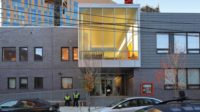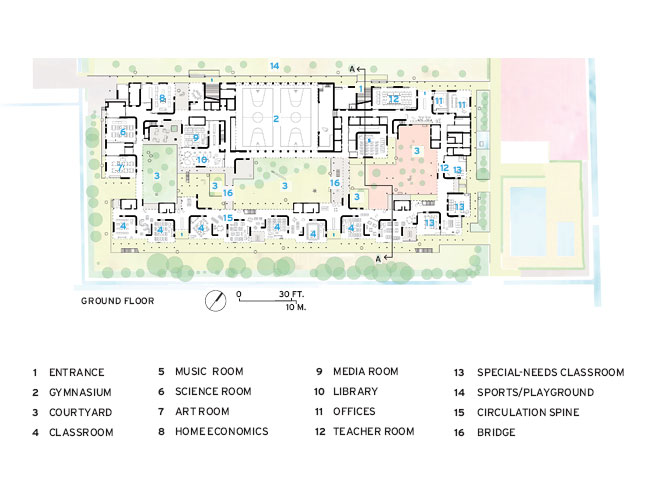Uto Elementary School
A Breath of Fresh Air: A Tokyo firm replaces an outdated schoolhouse with a vibrant, flexible facility that satisfies stringent seismic codes and provides a healthy environment.


















Architects & Firms
Uto, Japan
In Japan, where the birthrate is dropping and the elderly population is rising, more schools are closing than opening. But in Kumamoto prefecture on the nation's southernmost island, Kyushu, the city of Uto was faced with an aging elementary school and nearly 800 youngsters to educate. Under the aegis of Kumamoto Artpolis, a prefectural program that engages architects for public works, Uto's Board of Education held a proposal competition and awarded the commission for a brand-new building to the Tokyo firm and de facto school specialists CAt.
CAt's replacement capitalizes on the idea of generous glazing but improves accessibility and flow with a long, two-story structure that features a sequence of courtyards running down the middle. Surrounded by a blend of paddy fields and residential blocks, the building has five entrances, enabling students to approach it from multiple directions. The main doorway is on the north, facing an expansive sports and play field. It leads to a reception area flanked by administrative offices and a teacher room. Double-height gymnasium and library spaces, plus rooms for science, music, home economics, and other special subjects occupy the remainder of the ground floor here. The north side's second floor and both levels on the south side contain 28 classrooms, including four for special-needs kids.
Typically, Japanese public-school classrooms are defined by four walls and aligned along a single-loaded corridor. Here the classrooms consist of semi-enclosed teaching areas organized on a 9-foot-square grid and partitioned by open-ended, L-shaped walls with rounded corners and windowlike openings. A circulation spine loosely ties the classrooms together, but, unlike most school halls, it is an ambiguous space that shrinks and swells along its length, incorporating informal assembly areas, clusters of tables, and the requisite blocks of sinks at every grade level.
Less contained than their conventional counterparts, the classrooms open both to the circulation area and to adjacent spaces used for small-group learning and storage. Teachers can arrange their 753-square-foot learning spaces freely since the rooms have no predetermined 'front,' and movable furniture'blackboards on wheels, rolling cubbies, custom bean-shaped tables, and standard desks'slides easily.
In addition to delineating space, the L-shaped walls are integral structural elements. Made of reinforced concrete, the 16-inch-thick planes carry vertical loads and counter lateral and earthquake forces. Together with steel columns ringing the building's perimeter, they support the flat, void slabs overhead to yield 33-foot-long, clear spans. Extending the entire building height, the hefty wall segments poke through the roof and incorporate operable clerestory windows that draw fresh air up through the school. As in all Japanese public schools, there is no air-conditioning system.
To mitigate the area's hot, humid summers, the architects wrapped the building with full-height, folding fenestration. Developed for Japanese-style archery ranges, the aluminum-framed window walls are easily pushed aside, turning the building into a giant engawa, or traditional covered porch.
The windows work in tandem with the courtyards that capture breezes blowing in from Mount Haku to the west. Each of these five connected gardens has a different character: One is dotted with fruit-bearing trees, another hosts playground equipment. Outdoor tables and built-in benches make every exterior space kid-friendly. Four covered bridges spanning the courtyards link the school's two sides. Enclosed by the operable window walls, these decked paths provide protected yet airy traffic flow'even when it rains.
The school's permeability not only responds well to the climate, but it has the potential to loosen the rigid pedagogical conventions prevalent in Japanese public schools. Though such an open plan makes it difficult to control noise, according to CAt principal Kazuko Akamatsu, the positioning of the perpendicular walls minimizes sound transfer, and installed acoustical insulation in the ceiling and at classroom entrances helps muffle sound not absorbed by the concrete walls and solid birch floors. Careful scheduling also prevents boisterous activity from disrupting quiet study.
Teachers not used to the visual exposure, or unsure of how to use the flexible space, might need to adjust to the quasi-open classrooms. 'For conservative teachers it can be difficult,' remarks Akamatsu. 'But for others it is exciting.' Maybe the school's most discerning critics are the students themselves. 'The kids enjoy their school so much,' says Kojima. 'Maybe that is a problem for some teachers.'
Naomi R. Pollock, RECORD’s Tokyo-based special international correspondent, is author of Made in Japan (Merrell Publishers, 2012).
Completion Date: July 2011
Gross square footage: 92,247 square feet
Total construction cost: approximately $18.5 million
Pitch Perfect: Cooler than a storefront, this after-school learning center couldn’t be much smaller, but the architects packed it with big ideas.
 |
 |
| The tiny building is clad in metal from the tip of its 72.6-degree pitched roof to its concrete ground level (top). A glass work table, supported by quarter-inch-thick steel plates, hovers over the floor below (above). |
For over 50 years Kumon's learning centers in Japan have attracted students eager to enrich their formal pre-K-to-12 education with its motivating programs. The curriculum is controlled, but there are no rules about space. So when asked to create a facility in Kyoto, architects Takashi Yonezawa and Naoki Nomura saw an opportunity to give architectural expression to the school's systematic study method.
Capped with a steeply pitched roof, the 657-square-foot, pixie-like building straddles a busy boulevard and a quiet residential street that drops down 7 feet. There is one entrance and one room per level. The classroom is on the upper floor; the ground level serves as a multi-use space for community art classes and activities. An internal stairway links the levels, while an ingenious glass table or work surface upstairs joins them visually.
Made of two thick sheets of glass supported by steel plates, the table is 'so strong, kids can jump on it,' says Yonezawa. But most of the time they use it to work on their exercise sheets. A built-in counter wrapping the room's perimeter provides additional desk space. Overhead, the ceiling soars to 23 feet at its apex, but views are conspicuously absent. 'On the upper floor, concentration is important for study,' explains Yonezawa. 'The lower floor is for fun.'
In contrast to the pristine, exposed-steel structure above, earthy materials, such as concrete for the floor and wood for the table, dominate the lower level. Shelves for work sheets line one long wall; sliding glass doors open to a parking area and fill the room with daylight, forging a connection to the neighborhood'a densely built area on the city's south side packed with narrow, Kyoto-style townhouses. Against this backdrop, the steeply gabled, galvanized-steel-andaluminum- clad building both blends in and stands out. —N.R.P.
Location: Kyoto, Japan
Completion Date:April, 2011
Gross square footage: 60.68m2
Total construction cost: Undisclosed
Personnel in architect's firm who should receive special credit: Takashi Yonezawa (HAP+) & Naoki Nomura (Takenaka Corporation)
Structure engineer: Atushi Fujio
General contractor: Hirota Co., Ltd
PeopleOwner: Architect: Personnel in architect's firm who should receive special credit: Associate architect(s): Kazuma Yamao, Shinya Omura, Shuhei Ito, Yoshinobu Shimoyama, Mitsuru Hamano, Koji Misaki, Ai Oishi Engineer(s): Landscape: GA Yamazaki Other: Photographer(s): Sadao Hotta |
ProductsStructural system Exterior cladding Roofing Windows Interior finishes Wall coverings: Clear coating (SK Kaken Co., Ltd.) Floor and wall tile:White birch wooden floor (Kumasyo Sangyo) Conveyance Plumbing |













